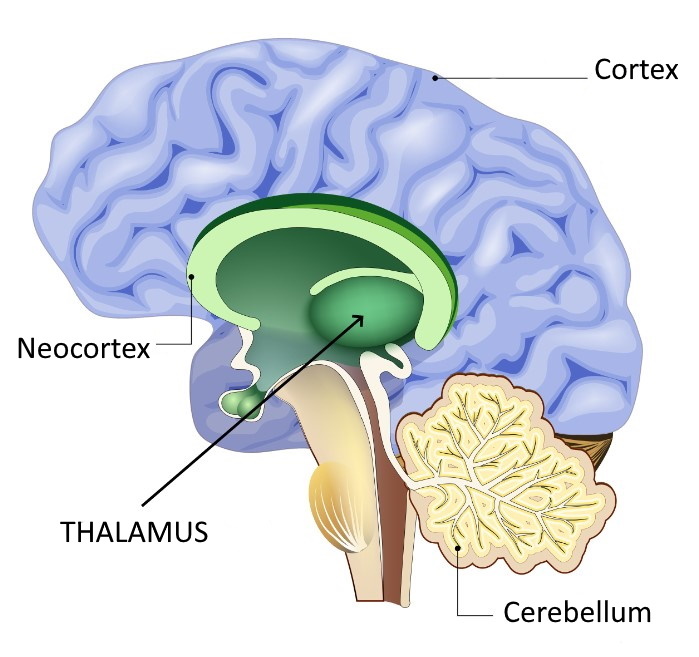The thalamus (plural: thalami) is the largest of the structures that are part of the diencephalon.
The thalamus is practically located in the center of the brain.
Function of the thalamus
The thalamus acts as a relay center between the lower midbrain and the spinal cord and cerebral cortex.
It receives and distributes information between the peripheries and higher centers such as the cerebral cortices.
It has a privileged relationship with the cortex sending and receiving information from several cortical areas. The signals go back and forth regularly between the thalamus and the cerebral cortex, with the thalamus activating the cortex and vice versa.
It is also closely associated with the basal ganglia, relaying signals from the basal ganglia to the cortex.
It contributes to functions such as:
- consciousness
- the sleep
- memory
- sensory (somesthetic, visual, auditory) and motor functions
Signal relay area
It is essentially an important relay station directing both sensory signals to the appropriate areas of the cortex and regions of the forebrain. Here are examples of signals:
- Somatosensory signals (touch, pressure, pain, temperature, etc.).
- Visual signals to the occipital cortex.
- Auditory signals to the temporal lobe gyrus.
- Muscle control signals from the cerebellum, midbrain and other brainstem regions to the motor cortex and basal ganglia.
Anatomy
Structurally, the thalamus is composed of two symmetrical egg-shaped masses (thalami) which are usually joined in the midline by a band of gray matter.
It is surrounded by two thin layers of white matter.
Its gray matter is separated by a Y-shaped layer of white matter called the internal medullary lamina.
This structure divides the thalamus into anterior, middle and lateral parts. These three parts contain the largest groups of thalamic nuclei.
Each of the thalamic nuclei is subdivided into different sub-nuclei according to their location and their afferents (neurons which project towards the thalamus) and their efferents (neurons which project from the thalamus towards other structures) in particular cortical, striatal and cerebellar (cerebellum).
Blood circulation
The thalamus is mainly supplied by small arteries arising from the posterior cerebral artery. There are four vascular territories:
- anterior (or tuberothalamic): supplied by the thalamotuberal arteries which are branches of the posterior artery;
- paramedian: paramedian arteries branching off from the posterior cerebral artery;
- lateral: supplied by arteries which are branches of the posterior cerebral artery;
- posterior.
Pathology associated with damage to the thalamus
- thalamic syndrome: contralateral hemianaesthesia, often accompanied by mood swings;
- thalamic infarction;
- gliome thalamique.

